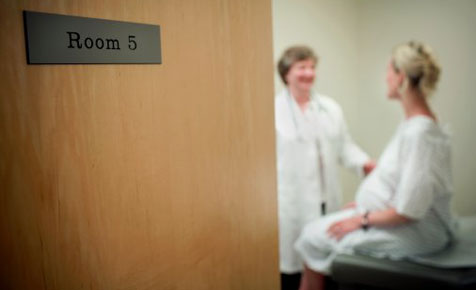The medical term ‘presentation’ refers to the part of the baby that is leading the way down the birth canal. In most cases the crown of the baby’s head leads the way, often referred to as a ‘vertex presentation’.
Occasionally (about 1 in every 400 births, or 0.25%) the baby is lying across ways in the uterus, called a ‘transverse lie’. When this happens, the baby’s back or shoulder covers the woman’s cervix. This is known as a ‘shoulder presentation’. There are many causes for a shoulder presentation, that usually involve a situation where the baby is able to change position frequently and easily, (often referred to as an ‘unstable lie’).
These include:
- Women having their second or subsequent baby. This is because the abdominal muscles are more flexible, allowing the baby to move more easily.
- The baby is preterm. Babies born before 34 weeks generally change position quite frequently and could easily be in a transverse position when the labour starts.
- There is a large amount of amniotic fluid. This is often referred to as ‘polyhydramnios’.
Sometimes the baby is unable to achieve a head or bottom down position due to other health conditions.
These can include:
- Placenta previa. This is where the placenta is implanted low in the uterus, sometimes covering the opening of the cervix. This can be detected by an ultrasound.
- You are carrying twins. Sometimes the second twin can be transverse because the first twin is engaged in the pelvis.
- The woman has a ‘bicornuate uterus’. This is where the woman has a piece of tissue or ‘septum’ inside the uterus that extends from the top of the uterus or fundus, (not unlike a stalactite descending from the roof of a cave). The baby’s movement is restricted and they are unable to get into a head down, or bottom down position, remaining transverse. This can be detected by an ultrasound.
How will my caregiver know?
There are two observations your caregiver can use, to possibly determine if your baby is distressed.
These are:
- An irregularity in the baby’s heart rate. This is usually picked up through the caregiver listening to the baby’s heart rate after a contraction, every half an hour with either a Pinard’s earpiece, or a hand held Doppler machine, or through continuous monitoring of the baby’s heart rate on a CTG machine, to see if there is an abnormal pattern in the heart rate.
OR:
- Heavy (or thick) meconium staining of the amniotic fluid. This is when the baby opens their bowels inside the woman’s uterus, making the waters look green, or brownish, in colour. Meconium staining can be light (lots of fluid with a slight discolouration), which may (or may not) be a concern, just requiring ongoing observation. However, it can be heavy or thick, similar in consistency to pea soup, which is usually more of a concern.
- If meconium is seen, but the baby’s heart rate is normal, the baby is not considered to be distressed, but if the baby’s heart rate is abnormal as well, then the perception of distress is more accurate.
How will it affect my labour?
The main concern for babies lying frequently in a transverse position, or in an oblique lie, is that if the waters break, the cord can prolapse down into the woman’s birth canal. A cord prolapse is when a loop of the umbilical cord (attached to the baby at one end and the placenta at the other) falls past the baby, through an open cervix and into the woman’s vagina. This can be life threatening for the baby, as the umbilical cord can become compressed by the baby’s body pinching it against the woman’s bony pelvis, restricting the blood and oxygen flow to the baby. When a cord prolapse does happen, time is of the essence to deliver the baby as soon as possible, usually by an emergency Caesarean operation.
Some caregivers advocate doing a routine Caesarean, ‘just in case’ this happens. Others try and turn the baby, called an ‘external version’, (a similar procedure to when a caregiver tries to change a baby from a breech position, to a head down position, but usually much easier if the baby is very mobile). This is only possible if there are no obvious complications, such as placenta previa. Often turning a baby is unsuccessful, because they are constantly changing position, rarely staying head down.
Another technique is trying an external version when the woman is in early labour. Often the contractions are able to push the head (or bottom) down into the pelvis, and ‘keep’ the baby in that position until the birth. If the baby can be turned easily into a head down position, the waters may be broken by the caregiver, to remove some of the fluid that helps the baby change position frequently. This is also one way to induce the labour, and in this circumstance may still put you at a slight risk of the cord prolapsing, if the baby’s head is high and unengaged in the pelvis.
Babies who continue to present shoulder first, will need to be born by Caesarean.
Twins in which the second twin is transverse will often turn (or are able to be turned) once the first twin is born, so that the second baby can be born vaginally (either head first or in a breech position). The turning of a second twin will either be done externally, or internally.
External version (or ECV) entails the caregiver manipulating the baby through feeling the woman’s belly. This is usually tried first. An internal version (or IPV) means that the caregiver places their hand into the vagina and lower uterus, taking hold of the baby’s feet, to ease them down to be born in a breech position.







Leave A Comment
You must be logged in to post a comment.